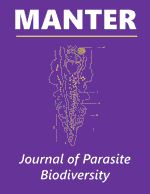Parasitology, Harold W. Manter Laboratory of
ORCID IDs
Boeger https://orcid.org/0000-0002-6004-2822
Brooks https://orcid.org/0000-0002-7891-9821
Földvári https://orcid.org/0000-0001-5297-9036
Gardner https://orcid.org/0000-0003-3133-740X
Hoberg https://orcid.org/0000-0003-0819-7437
Kharchenko https://orcid.org/0000-0002-3824-2078
Molnár https://orcid.org/0000-0002-2458-4659
Trivellone https://orcid.org/0000-0003-1415-4097
Date of this Version
11-5-2022
Document Type
Article
Citation
MANTER: Journal of Parasite Biodiversity (ISSN 2470-8224) Occasional Papers, Number 21, November 3, 2022
doi: 10.32873/unl.dc.manter21
https://digitalcommons.unl.edu/manter/
Abstract
Globally, humanity is coming to recognize the magnitude of the interactive crisis for emerging infectious disease (EID). Strategies for coping with EID have been largely in the form of reactive measures for crisis response. The DAMA protocol (Document, Assess, Monitor, Act), the operational policy extension of the Stockholm paradigm, constitutes a preventive/proactive dimension to those efforts. DAMA is aimed at focusing and extending human and material resources devoted to coping with the accelerating wave of EID. DAMA is integrative, combining efforts to strategically document the distribution of complex pathogen and host assemblages in the biosphere in the context of dynamic environmental interfaces that provide the opportunities for pathogen exchange and emergence. Movement of habitats and animals (a breakdown in ecological isolation) catalyzed by climate change and broader anthropogenic trajectories of environmental disruption provide the landscape of opportunity for emergence. Evolutionarily and ecologically conserved capacities for exploitation of host-based resources allow pathogens to persist in one place or among a particular spectrum of hosts and provide insights to predict outcomes of persistence and emergence in novel conditions and across changing ecological interfaces. DAMA trajectories combine “boots on the ground” contributions of citizen scientists working with field biologists in development and application of sophisticated archival repositories, bioinformatics, molecular biology, and satellite surveillance. DAMA is a focus for anticipation, mitigation, and prevention of EID through knowledge of pathogens present in the environment and actions necessary to diminish risk space for their emergence. DAMA can be an effective strategy for buying time in the arena of accelerating environmental and socioeconomic disturbance and expanding EID linked to a future of climate change. Information + action = prediction and lives saved in a realm of EID.
This article has been produced in support of and with appreciation for the efforts by Gábor Földvári of the Institute of Evolution, Centre for Ecological Research, and the Centre for Eco-Epidemiology, National Laboratory for Health Security (both located at 1121 Budapest, Konkoly-Thege Miklós út 29-33, Hungary). Through his untiring efforts, team building, and leadership, he has secured the first EU-wide team research grant. This work was supported by the National Research, Development and Innovation Office in Hungary (RRF-2.3.1-21-2022-00006) and the COST Action CA21170 “Prevention, anticipation and mitigation of tick-borne disease risk applying the DAMA protocol (PRAGMATICK),” which represent the first funded efforts to apply the principles of the DAMA protocol.


Comments
Copyright © 2022 Eric P. Hoberg, Walter A. Boeger, Orsolya Molnár, Gábor Földvári, Scott L. Gardner, Alicia Juarrero, Vitaliy Kharchenko, Eloy Ortiz, Wolfgang Preiser, Valeria Trivellone, and Daniel R. Brooks
License: Creative Commons Attribution-NonCommercial-ShareAlike 4.0 International